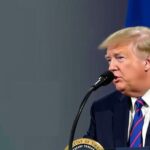India Aims to Rebuild Its Global Trade Image by Reducing Tariffs
Finance Secretary Tuhin Kanta Pandey announced India’s intention to shed its protectionist image, aiming to promote a competitive economy open for business. This comes ahead of new U.S. tariffs affecting global markets, with India considering trade agreements and reduced tariffs to strengthen ties with the U.S. The average tariff has decreased, reflecting a significant shift in India’s trade strategy. Additionally, India’s stance on BRICS and currency concerns was clarified, emphasizing no desire to replace the dollar.
In a recent interview, Finance Secretary Tuhin Kanta Pandey expressed India’s intent to abandon its reputation as a protectionist nation. Pandey emphasized that India is “not a tariff king” and is open for business, showcasing its competitive economy. This statement comes ahead of President Trump’s announcement of new tariffs that impacted global financial markets.
India’s approach appears proactive, as it evaluates pathways to enhance trade relations with the United States, including reducing tariffs and committing to import more American goods. Additionally, the Indian government indicated readiness to assist in addressing undocumented Indian migrants in the U.S.
In light of India’s evolving trade landscape, the average tariff rate has decreased from 11.65% to 10.66%. Sanjay Kumar Agarwal, the chairman of the Central Board of Indirect Taxes and Customs, underscored the significance of these modifications, calling them a necessary response to shifting geopolitical dynamics.
Pratik Jain from PwC India highlighted that the tariff adjustments are a crucial step towards simplifying India’s trade framework, particularly as the country strives to integrate more into global supply chains amidst geopolitical tensions.
The finance secretary also addressed Trump’s concerns about the BRICS nations and the potential for tariffs against them should they consider a common currency. Pandey reassured that India has no intentions of replacing the dollar as a key currency nor does it align with China on this matter.
India’s recent tariff adjustments signal a strategic shift towards increasing international trade relations and a commitment to global economic integration. By lowering tariffs and promoting a business-friendly image, India aims to encourage foreign investments and boost its economic profile. This approach is particularly relevant in the context of ongoing trade tensions between the U.S. and other nations, including potential retaliatory measures that could affect global markets. The government’s focus on not utilizing tariffs as a protectionist tool reflects a desire to be an integral part of global supply chains, adapting to the evolving landscape influenced by geopolitical changes. This strategy also aligns with India’s broader economic goals, as it seeks to balance domestic priorities while engaging cooperatively with global partners.
In conclusion, India’s commitment to shedding its protectionist image is underscored by recent tariff reductions, signaling a more competitive and open economy. The government’s proactive stance in improving trade relations, especially with the United States, aims to enhance economic growth and integration into global supply chains. As India navigates complex geopolitical challenges, its strategies reflect a desire for constructive engagement rather than isolation. Overall, this shift is crucial for attracting foreign investments and fostering a more diversified economic environment.
Original Source: m.economictimes.com








Post Comment